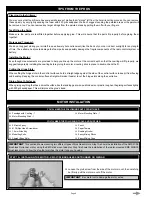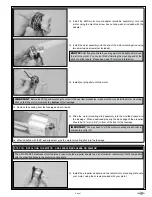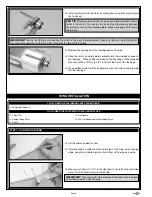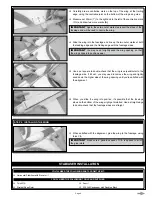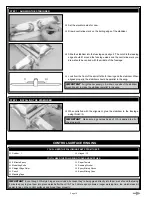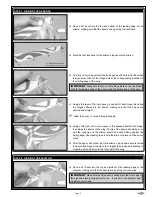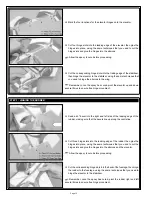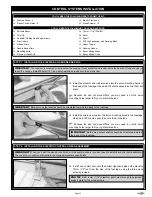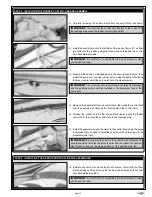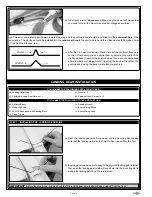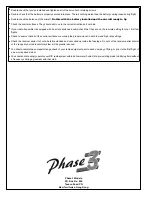
Page 9
BaLaNCe POiNt aNd CONtrOL tHrOWs
ailerons:
30mm (1-3/16") up and down
elevator:
25mm (1") up and down
rudder:
50mm (2") right and Left
sport flying
ailerons:
as Much as Possible up and down
elevator:
as Much as Possible up and down
rudder:
as Much as Possible right and Left
3d flying
ailerons:
30%
elevator:
30%
rudder:
30%
sport flying
3d flying
ailerons:
40%
elevator:
40%
rudder:
40%
Exponential 'softens' the response of the control surfaces around the neutral stick position. This makes the aircraft easier to control
while using such large control throws. The Exponential values shown are given as a percent. Please note that different brands of radio
control systems may call for + or - Expo. Please check your transmitter's owners manual for more info.
THE CONTROL THROWS ARE MEASURED FROM THE WIDEST POINT OF THE CONTROL SURFACES
the Centre of Gravity (C/G or Balance Point) is 95mm (3-3/4") back from the leading edge of the tOP wing, measured at
the sides of the fuselage.
BaLaNCe POiNt
WARNING
For test flying and general sport flying, we suggest you balance the aircraft at the C/G recommended above. For 3D
flying, you may want to experiment moving the C/G back in small increments until you're satisfied with the result.
CONtrOL tHrOWs
exPONeNtiaL
To ensure great flight performance and to be able to trim your aircraft properly, it is critical that you adjust the motor thrust as
necessary. When set properly, the trim for the elevator and the rudder should be neutral. Fine-tune the down-thrust and right-thrust
amounts until this neutral trim is achieved.
MOtOr tHrust
q
For the stick mount, carefully trim the end of the motor mounting
stick at a slight angle, so that the motor will have approximately
2º of down-thrust and right-thrust.
q
For the radial mount, add a thin washer between the top and
right side of the motor mount and mounting plate, so the motor
will have approximately 2º of down-thrust and right-thrust.
PrefLiGHt CHeCK aNd safety
l
Check the operation of the throttle. Double-check that you're getting full power when the throttle control stick is at full.
+
If you're using a computer radio, you may need to increase your throttle channel's EPA setting to result in full power. (Refer to
your radio system's operating guide for further information.)
l
Check the condition of the transmitter batteries. They should be fully charged.
l
Check every glue joint in the aircraft to ensure that everything is tight and well-bonded.


